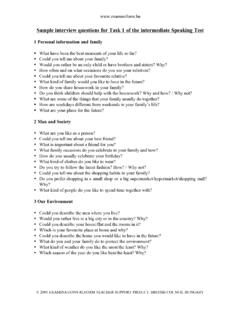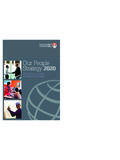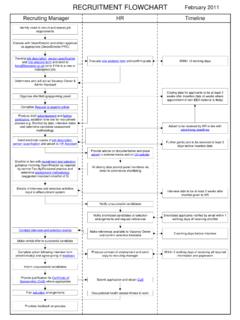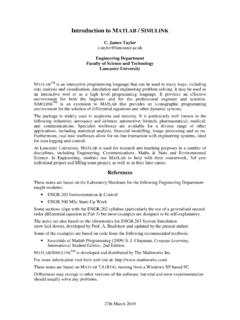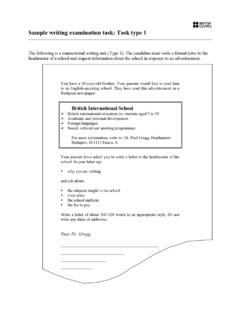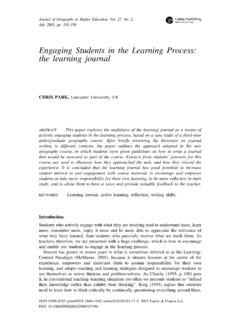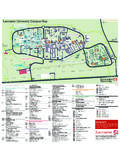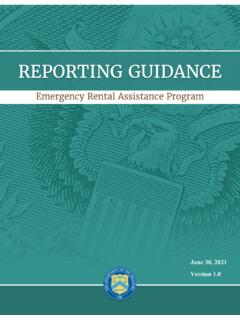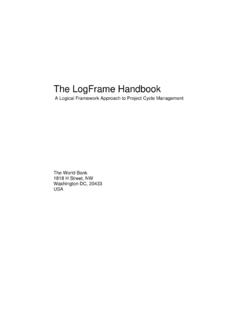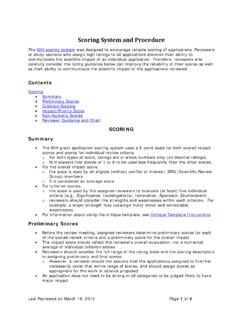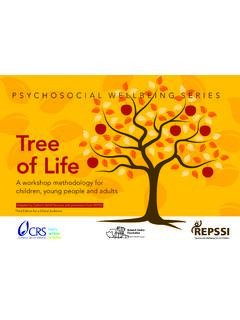Transcription of Guidance on the Conduct of Narrative Synthesis in ...
1 Guidance on the Conduct of Narrative Synthesis in Systematic Reviews A Product from the ESRC Methods Programme Jennie Popay1 Helen Roberts2 Amanda Sowden3 Mark Petticrew4 Lisa Arai2 Mark Rodgers3 Nicky Britten5 with Katrina Roen and Steven Duffy 1 Institute for Health Research, Lancaster University 2 Child Health Research and Policy Unit, City University 3 Centre for Reviews and Dissemination, University of York 4 MRC Social and Public Health Sciences Unit, University of Glasgow: Mark Petticrew is funded by the Chief Scientist Office of the Scottish Executive Department of Health 5 Peninsula Medical School, Universities of Exeter and Plymouth Version 1: April 2006 2 3 TABLE OF CONTENTS Page 4 Chapter 1 Introduction and the Purpose of the 5 Chapter 2: The main elements in a systematic review 9 Chapter 3: Guidance on Narrative Synthesis an 11 Chapter 4: Applying the Guidance 1: effectiveness 25 Chapter 5: Applying the Guidance 2: implementation 51 Chapter 6: Implications for future 67 69 Appendix 1: Methods used in the production of the 73 Appendix 2.
2 Bibliography of methodological texts used in the production of the 87 4 ACKNOWLEDGEMENTS The research reported here was funded by the ESRC (Grant reference number H33250019) within the ESRC Methods Programme. There are many people who have contributed to this work along the way to whom we would like to extend our thanks. We are grateful to Professor Angela Dale, the Director of the programme for her support throughout the project. We are also grateful to the international panel of experts in research Synthesis including in particular: Professor David DuBois, University of Illinois; Dr Jeanne Daly, Mother and Child Health Research, La Trobe University; Professor Mike Fisher, Social Care Institute for Excellence; Angela Harden, The EPPI Centre, Institute of Education, London; Professor Cindy Mulrow, University of Texas; Dr Pierre Pluye, McGill University; Professor Helen Thomas, McMaster University; Dr Carl Thompson, University of York; Dr Heather McIntosh, NHS Quality Improvement Scotland; and Ros Collins, Dr Catriona McDaid and Dr Nerys Woolacott at CRD University of York.
3 The extensive and invaluable comments from panel members helped us to improve on earlier versions of this Guidance but the responsibility for the final product is, of course, entirely our own. Finally, we would like to thank the individuals in our various administrative teams and research support offices who have supported the work in many ways. Thanks are due in particular to Erja Nikander, Yvonne Moorhouse, and Vicki Bell in Lancaster and Mel Bryan at City who helped at various points with producing documents, travel arrangements, organising meetings, managing budgets and to Lisa Stirk at CRD in York and Vicki Bell at Lancaster who developed and maintain our website.
4 We would also like to pay tribute to Professor Sally Baldwin who died as a result of an accident in October 2003. Sally developed the proposal for this work with us. There have been many tributes to her extraordinary qualities as a researcher, teacher, colleague and friend. We will not repeat these here suffice it to say that her stimulating and good humoured contributions to our intellectual endeavours have been badly missed. 5 CHAPTER 1: ABOUT THE Guidance Do domestic smoke alarms save lives? Can young offenders be 'scared straight' through tough penal measures? What factors should be considered when designing and implementing a multi-sectoral injury prevention programme in a local area?
5 Making sense of large bodies of evidence drawn from research using a range of methods is a challenge. Ensuring that the product of this Synthesis process can be trusted is important for policy makers, for practitioners and for the people research is intended to benefit. There are a number of ways in which research evidence can be brought together to give an overall picture of current knowledge that can be used to inform policy and practice decisions. However, the trustworthiness of some of these methods remains problematic. The Guidance we set out here focuses on a particular approach - Narrative Synthesis . Variants of this approach are widely used in work on evidence Synthesis , including Cochrane reviews, but there is currently no consensus on the constituent elements of Narrative Synthesis and the conditions for establishing trustworthiness notably a systematic and transparent approach to the Synthesis process with safeguards in place to avoid bias resulting from the undue emphasis on one study relative to another are frequently absent.
6 This Guidance therefore aims to contribute to improving the quality of Narrative approaches to evidence Synthesis . Telling stories the nature of Narrative Synthesis Narrative Synthesis is sometimes viewed as a second best approach for the Synthesis of findings from multiple studies, only to be used when statistical meta-analysis or another specialist form of Synthesis (such as meta-ethnography for qualitative studies) is not feasible. In fact, even when specialist methods are used to synthesise findings from multiple studies, those who want to increase the chances of a scientific Synthesis being used in policy and practice are likely to find a Narrative Synthesis helpful in the initial stages of a review.
7 Recognising this, the Guidance on undertaking systematic reviews produced by The Centre for Reviews and Dissemination at the University of York suggests that reviewers should first undertake a Narrative Synthesis of the results of the included studies to help them decide what other methods are Narrative Synthesis is a form of story telling. We are part of a story telling culture, and bringing together evidence in a way that tells a convincing story of why something needs to be done, or needs to be stopped, or why we have no idea whether a long established policy or practice makes a positive difference is one of the ways in which the gap between research, policy and practice can start to be bridged.
8 Telling a trustworthy story is at the heart of Narrative Synthesis . Narrative Synthesis , Narrative reviews and evidence Synthesis Narrative Synthesis refers to an approach to the systematic review and Synthesis of findings from multiple studies that relies primarily on the use of words and text to summarise and explain the findings of the Synthesis . Whilst Narrative Synthesis can involve the manipulation of statistical data, the defining characteristic is that it adopts a textual approach to the process of Synthesis to tell the story of the findings from the included studies. As used here Narrative Synthesis refers to a process of Synthesis that can be used in systematic reviews focusing on a wide range of questions, not only those relating to the effectiveness of a particular intervention.
9 Narrative review is a phrase some commentators have used to describe more traditional literature reviews and they are typically not systematic or transparent in their approach to Narrative Synthesis - the focus of this Guidance - in contrast, is part of a larger review process that includes a systematic approach to searching for and quality appraising research based evidence as well as the Synthesis of this evidence. A Narrative review can also be another name for a description, and is used in fields as diverse as performance review of staff3 to assessing familial patterns in colorectal Narrative reviews in the sense of traditional literature reviews can be distinguished from Narrative Synthesis as the latter refers specifically to a specific approach to that part of a systematic review process concerned with combining the findings of multiple studies.
10 Evidence Synthesis includes, but is not restricted to, systematic reviews. Findings from research using a wide range of designs including randomised controlled trials, observational studies, designs 6that produce economic and qualitative data may all need to be combined to inform judgements on the effectiveness, cost-effectiveness, appropriateness and feasibility of a wide range of interventions and policies. Evidence syntheses may also addresses many other types of questions including, for example, questions about the current state of knowledge on the causes of particular health or social problems. They are also undertaken in diverse fields from health services research and sociology to engineering and urban planning.
